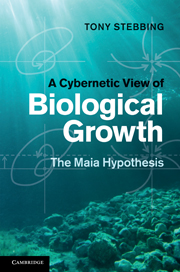Book contents
- Frontmatter
- Contents
- Foreword by Ernest Naylor
- Preface: ‘A fragment of a possible world’
- Acknowledgements
- 1 Introduction
- 2 Growth unlimited: blooms, swarms and plagues
- 3 Self-regulating systems: from machines to humans
- 4 The wealth of homeodynamic responses
- 5 A cybernetic approach to growth analysis
- 6 A control mechanism for Maia
- 7 The three levels of adaptation
- 8 Population growth and its control
- 9 Hierarchy: a controlled harmony
- 10 History of hormesis and links to homeopathy
- 11 Maian mechanisms for hormesis and catch-up growth
- 12 Cellular growth control and cancer
- 13 Human overpopulation
- 14 Our finite Earth
- 15 The Maia hypothesis and anagenesis
- Glossary
- Further reading
- References
- Index
7 - The three levels of adaptation
Published online by Cambridge University Press: 10 January 2011
- Frontmatter
- Contents
- Foreword by Ernest Naylor
- Preface: ‘A fragment of a possible world’
- Acknowledgements
- 1 Introduction
- 2 Growth unlimited: blooms, swarms and plagues
- 3 Self-regulating systems: from machines to humans
- 4 The wealth of homeodynamic responses
- 5 A cybernetic approach to growth analysis
- 6 A control mechanism for Maia
- 7 The three levels of adaptation
- 8 Population growth and its control
- 9 Hierarchy: a controlled harmony
- 10 History of hormesis and links to homeopathy
- 11 Maian mechanisms for hormesis and catch-up growth
- 12 Cellular growth control and cancer
- 13 Human overpopulation
- 14 Our finite Earth
- 15 The Maia hypothesis and anagenesis
- Glossary
- Further reading
- References
- Index
Summary
The whole organism can be seen as a coded representation of the environment.
J.Z. YoungLiving things without exception are endowed with purpose.
Jacques MonodKINDS OF ADAPTATION
Habitats fluctuate continually, and sometimes to extremes, making great demands on the organism's capacity to control its internal processes. The primary adaptation is the ability of a camel to control its own temperature, as it is the only large mammal able to survive the freezing nights and baking days of the great deserts. The most important means by which mammals keep cool is by heat loss due to sweating. For human beings, 10–12% water loss may well be fatal, but camels can lose twice as much water without harm, greatly increasing their capacity to tolerate heat. A camel can drink up to a third of its body weight in water, so can sweat copiously, and can survive for 6–8 days without drinking.
Man is a homeotherm, and has a lesser capacity to control internal temperature in extreme heat than a camel, or in extreme cold like a polar bear. Due to the work of Knut Schmidt-Nielsen and others, we know that the camel has thick fur for insulation, which not only keeps the cold out at night, but also dissipates the heat of the sun during the day. To shear a camel of its fur causes its body to heat up during the day, leading to an increase in water loss by as much as 50%.
- Type
- Chapter
- Information
- A Cybernetic View of Biological GrowthThe Maia Hypothesis, pp. 138 - 169Publisher: Cambridge University PressPrint publication year: 2010



